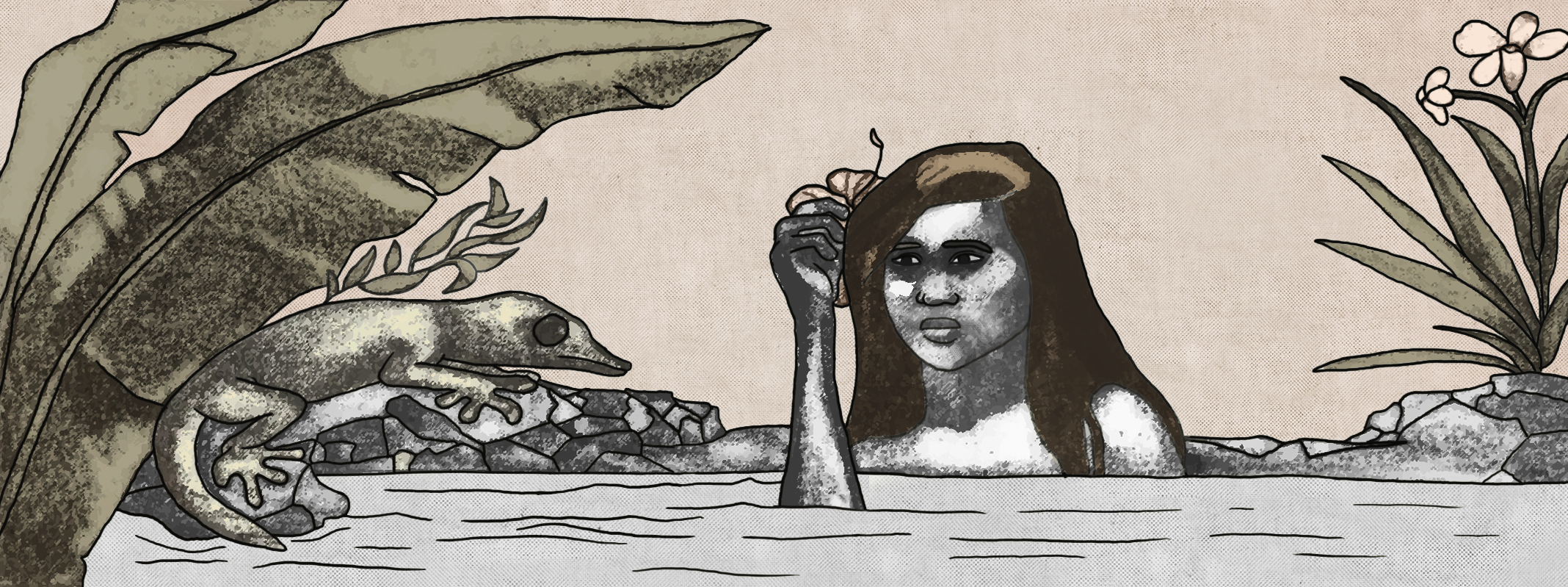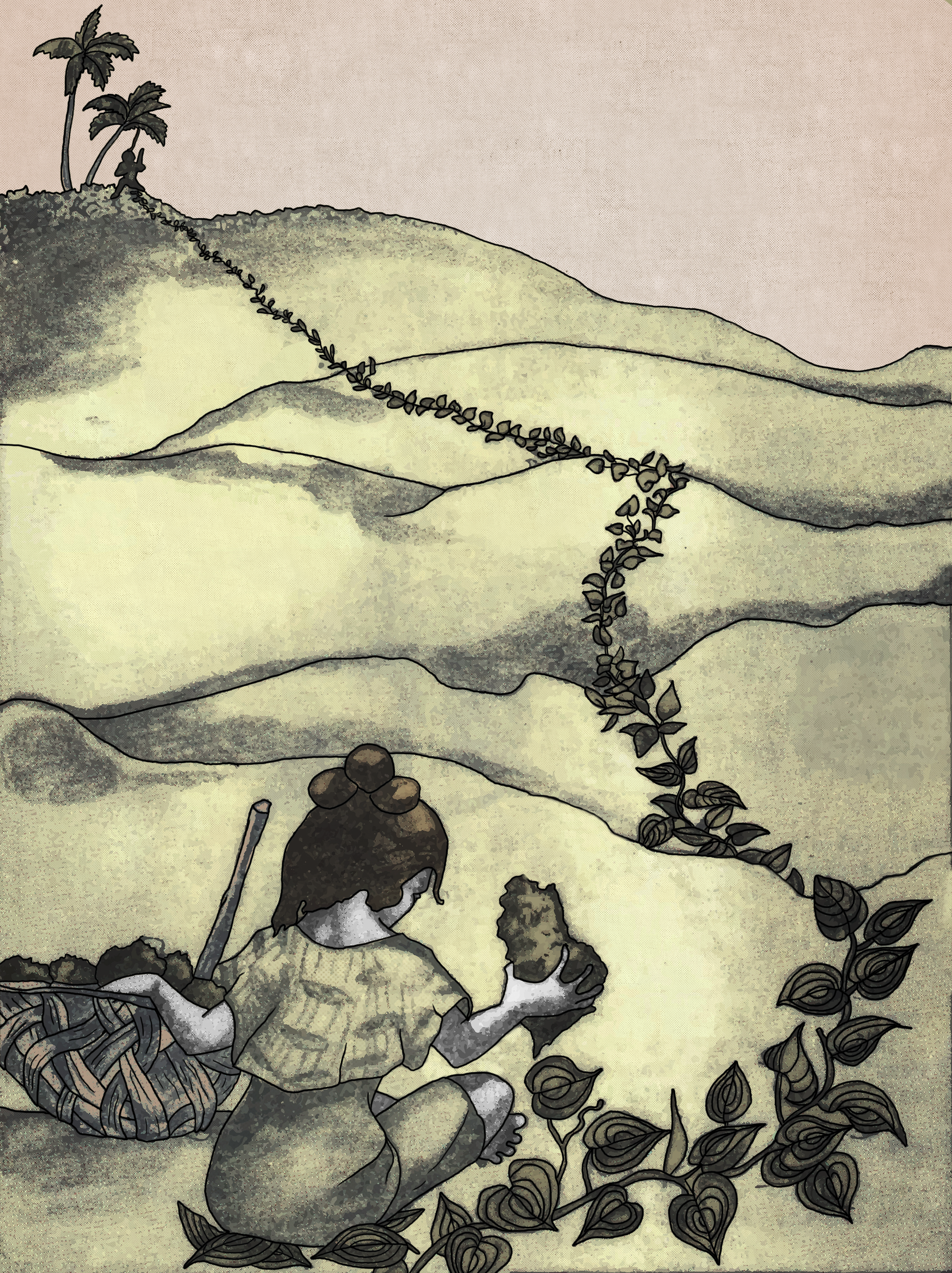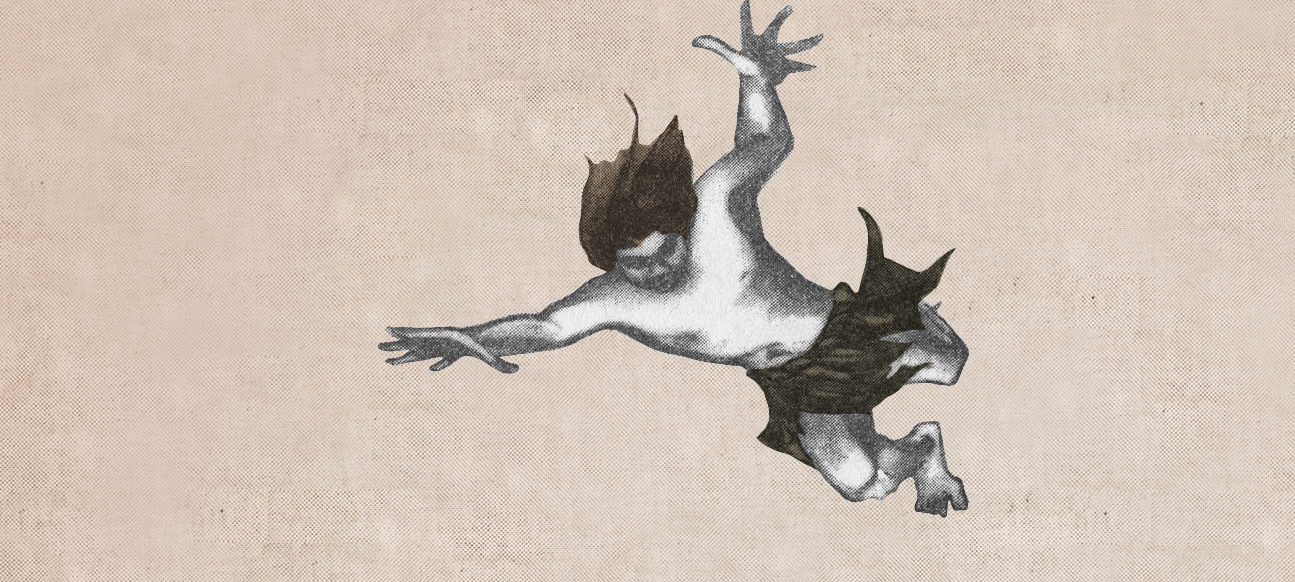
o lenei tama’ fta’i .na i’u ai ina malaga maf le Tui Ffti ma lā fa’aipoipo’. ‘0 lona tuagane ’o Pfli sa alofa tele ‘ i ā te ia, ma na augani atu ai ina ‘ia ‘avatu fo’i ma fa i’ lana malaga ‘i Fiti. Sā musu Sina, peita’i na i’u ina ma- lie lona loto, ona ia .tago lea ‘ua fafao si ona tuagane ‘i le taga o lona ‘ofu, ma malaga loa ma le Tui Fiti ‘i Fiti.ā leaga tele le matagi i aso o le faigāmalaga, ma na ‘umi ai le fō- lauga ma i’u ai ina leai se mea’ai mo 1e.’aumalaga. I lo lātou matelāina, na tonu ai i le Tui Fiti o le’ā fasioti Sina. Peita i, ‘o 1e mataala o Pili nafa’asaoinaai. Nata’uatuePili’olo’oteleufi’olo’oilaloole nofoa o le tupu.
Sā fa’apea lava ona ia fa’asaoina Sina i le tele o ni fa’alavelave na tutupu ‘i la lātou faigāmalaga atu’i Fiti, ‘A e pagā! ‘0 1e tasi aso ns tilo- tilo atu iii Pili, ma onoono ai ‘i fafo lona ulu mai le’ofu o Sina. Sā iloa atu e se tagata Fiti, ‘e uliuli lea manu,ma sā māsalosalo ‘o ia mataufa’a- lili atu ‘1 le teine. Sā o’o ina ita tele 1e teine ma na tago ifo ai se’i a’e Pili ma togi ‘i 1e sami. Peita’i, na ‘auina atu_eLoalana fānau e to’a^ lua? ‘o Fuia ma Ma’oma’o, ‘e fa’aola ‘i ā Pili, lō lā’ua uso. Sā vave ona la maua atu Pili ‘o ‘a’au pea i le sami (Pili’a’^u). ’A e le’i mana’o Pili e toe fo’i ma ona uso; sā naunau lava e alu pea ‘i le mea e alu āga’i ‘i ai Sina.
‘0 le mea lea na lā ‘aveina ai Pili mā tu’u i se motu e igoa ‘o Pu’aga- gana, ‘e lata ane ‘1 Fiti. ‘O.’inā na maua atu ‘i ai e I’uao ma Uluao, ‘o_le fānau a Tagaloalagi. Na toe liua Pili ma ‘avea ma taule’ale’a ‘aulelei; sā tagi atu ‘ina ‘ia ‘avatu ia i lo lā va’aalo. Sā fa’apea lava ona faia.Na le’i ‘umi ona alu o le malaga, ‘a e agi le afā, na matuā fefefe ai I’uao ma Uluao ma na lā’ua lalafi ai i le liu o le va’a, Sā tago aty lo^ Pil ‘i le foeuli ma alofa’i le va’a, ma lana tatalo atu pea ‘1 ā Tagaloa ina ‘ia fa’ataunu’u atu ia ‘i Fiti i lona tuafafine pele ‘o Sina. Sā fesoasoani Tagaloa mo lana faigāmalaga ma na taunu’u vaye ai ‘i Fiti. Sā alu loa ‘o ia ‘1 le vao ma ‘āmata ona totōina se ma’um^tga tele. Na te le’i va’ai lava ‘1 ā Sina; na te le ‘o iloa fo’i po ‘o fea ‘o nofo ai.
‘0 aso lava nā na tetqle ai le oge-mea’ai i Fiti; ‘o le ala fo’i lenā sā tele ai tama ma teine talavou na fasiotia ma ‘aina ina ‘ia ola ai le to’atele. Sā fa’apea fo’i ona tūlaga ai Sina, ‘auā sā taupule’esea ai lona ola ona ‘o fuafu^ga laya a le Tui Fiti. Sā iloa e Pili le puapuagā o lona tuafafine,’Na o’o ‘i le tasi aso, ona alu ane lea o Palai, ‘o le tasi itū’āiga o ufi, ma tu’uina atu lana fesoasoani ‘i ā Pili. Sa tupu ma ola le ufi lenei ‘o le palal ma ‘ua sosolo atu pea se’ia taunu’u lava ‘1 le umu o le Tui Fiti.
‘A ‘o ‘eli e Sina se lua e su’e ai se mea’ai, sa fa’afuase’i ona maua ai se ufi palal. ‘0 aso ta’itasi ‘uma lava sā ‘eli ai e Sina ma gagau se fāsi ufi mo lā ,8’ua mea’ai’i ma na i’u ai ina taunu’u atu ‘i lona tuaqane Sā tu’uina atu e Ptli ‘i lona tuafafine ana fa’ato’aga ‘uma laya ‘A ‘o Pili ’ua toe fo’i nei ‘i le lagi, peita’i na toe pa’u ifo fo’i M le ‘ele- ‘ele ma taunu’u ‘i Manu’a, ‘0 le māfua’aga lea o lona igoa ’o Pi1ioa’ū peita’i na te le’i 1loa lava 1e mee o Iq o nofo ai lona tuafafine. (Kramer).
(Se’i fa’atusatusa le tala ‘o i luga ma le tala lenei pei ona tusia e Stuebel)

‘0 Faleāseu sa iai ona afafine e to’alua ‘o Tinopōula ma Sina’afalua. Sa malaga Sina ‘i Fiti e tausi le tupu sā gasegasea. Mulimuliane, na fa’a- ipoipo Sina ma 1e Tui Fiti, ma na maua ai 1ā alo-tama e to’alua ‘o Suasami- ‘ava’ava ma Soalatetele’upegaofiti, ‘ātoa ma le alo-teine e to’atasi ‘o Muliovailele. ‘E Te’i ‘umi ‘a e maliu le_tama ‘o Suāsami. Na mavae ni nai aso, ona tupu a’e ai lea o se lā’au matagōfie lava i lona tu’ugamau. Ona ‘o a’a na tutupu a’e e pei ‘o ni tamatama’ilima, na fa’apea ai le ‘upu, “‘Oi, ‘o lo ‘o toe tutupu mai ona tamatama’ilima!” ‘0 lea na toe fo’i mai ai Sina ‘i Sāmoa ma ‘aumai lea lā’au matagōfie.
‘A ‘o malōlō Sina i Vailele, sā ia va’ai atu ‘i se ‘isumu ‘o ‘atia sina vāega o le lā’au, ma ‘ua niniva ai le ‘isumu. ‘0 le mea lea na fa’aigoa ai lea lau’ele’ele o Vailele ‘o le malae o Niniva. Sā toe malaga Sina ‘i Savai?
‘I Fagalele, ma ‘o ‘inā sa ia totō ai lea lā’au na ia ‘aumaia mai Fiti. Ma na fa’amaonia ai, ‘o le ulua’i ‘ava lava lenā.’0 le__teine ‘o Muliovailele na usu ‘i ai Tagaloalagi. ‘0 le lā tama ulūmatua sa fa’aigoaina ‘i ā Pili. Ona ‘o le ulavale tele o_lenei tama, na tonu ai i ona mātua e fa’apa’ū ifo mai le lagi. Na pa’ū pa’ū ifo lenei tama, ona i’u lea ina taunu’u ‘i Manu’a ma maua ai lona igoa ‘o Pilipa’ū.
‘Ina ‘ua taunu’u M Manu’a, sā fa’aipoipo loa Pili ‘i le afafine o le Tui Manu’a; peita’i, sā leaga ona tausi o ana mea faigāluega, ‘o le mea lea na toe alu’ese ai ma alu atu ‘i Vatia, Tutuila. ‘E le’i ‘umi ‘a e toe alu’ese fo’i ma malaga_atu ‘i Aleipata ma fa’asolo atu ai ‘i Ā’opo i Savai’i.
‘0 lana nopia’iga i Ā’opo na maua ai lona igoa ‘o Pili’opo.
Sā ia gāluea’iina loa se fa’ato’agā-talo tele lava i le lau’^ele’ele sā ta’ua ‘o Laolao, ‘e ‘āmata atu i A’opo e o’o ‘i Āsau.’Ona ‘o lenei gāluega ofoofogia,’na foa’iina ai e ali’i o Ā’opo le igoa ‘o Tagaloa Ā’opo. Peita’i, sa toe tupu fo’i se fa’alavelave; ‘o le mea lfea na ia tu’ua ai Ā’opo ‘a e alu ma nofo i Palapala, ‘o se nu’u-ā-uta i Amoa.

‘0 le tasi aso, na malaga atu ai Tui A’ana Tava’etele mai Fasito’o e asamo, po_’o le ‘aisi i^iapula taluai na ia fa’alogo i le tele naunau o le fa’ato’aga-talo a Pili, Na tu’uina atu e Pili ni tiapula, peita’i, ‘e le’i mafai ona ‘aveina nei’tiapula e taulele’a e luasefulu na ō atu ma Tui Ā’ana. Sa iloa atu e Pili lea meat ona faiatu ai lea e le Ifāina ‘o le’ā na ‘avatua tiapula ‘uma ‘i le isi itu o Savai’i ‘i lona talafātai.
Sā faigōfie i ā te ia ona ‘ave o nei tiapula ‘uma lava, peitah’, ‘o le amo sā ia ‘aveina ai le ‘avega,.na gau so’o ona ‘o le mamafa o le āmoga.
Mai Sattipa’‘ite. a’A sef fa maliga ātu at -f Ā’xana ma galueaMTna ai se tasi makumaga tele laya, na -‘āmata atu t fasfto’lo e o^o laya ‘i Lefaga.’O ‘inā lā, na tia*i ai; lana amo mulfmulf, ‘a e fa’vauta, na tupu lenei 1ābau ma ’avea ma fua’fu’a. Le’i pine ona fa’afpoipo Pilt ma Sinaaletava’e, le āfafine o Tui A’ana Tava-etele? ‘Tna *fa saunia ni’mea’ai lelei mo_lona to’-alua, sā ‘āmata ai net ona fuafua ma afafa e Pfli -nt ana -au-fāifaiva ta’uta’ua.

‘Ina ‘ia maua ni i’a se tele mai se gāluega fa’atauva’a, sā ta gaosia se ‘upega fāgota ma a’oa-o ai fo’,T ‘i tagata 1e gaosiga o ia ‘upega.’E fa’apea le tala; sā ia gaosia se ‘upega tele ma le ‘umi, na tala atu i’Upolu ‘a e o’o ‘i Savai’i. ‘0 le_te1e naunau o ni T a na maua i lenei
‘upega, na le’i mafai e va’a ‘uma sā iai ona aveina t uta.
‘0 le poto-māsani o Pili i le fāifaiva na māfua ai ona maua o ni isi o alagā’upu ta’uta’ua e pei ‘o: “‘Ua sa’a ‘i tai le ‘upega o Pili.” “‘Ua tu’utasi le faiva o Pili.”‘O le ‘upega e tautau ‘a e fāgota.

Two very chaste versions of the Pili story are given by Brother Fred Henry, one from the Manu’a Islands and the other from Western Samoa. The second version is told differently, so both of those are presented. It is important to recall that at an earlier time, Fijians occupied a portion of Savai’i. The Sina stories are also found throughout the site in the other volumes, and throughout Polynesian literature.
1) The Manu’a version:
The deities Pega and Pega had three children, two boys and a girl named Sina. The eldest Pilimoelagi, lived in Heaven, while his brother Pilimoevai (Pili) lived in the bathing pool of his parents in Lefaga at Upolu. Pili could change his form at will from animal to human, but at this time he was in the form of a large black lizard. Sina was forbidden to bathe in her parents’ pool, but eventually she disobeyed. When she came into contact with her brother Pili, the lizard in the pool, knowing she was dishonored, she fled from her home in Lefaga and arrived in Fitiuta in the Manu’a Islands. Unbeknownst to her, Pili had followed her to Manu’a.
At Fitiuta, she married Pulelei’ite and bore him several children. Here, she used a pool called Vailega. Not knowing that her brother Pili had followed her to Manu’a, Sina went one day to Vailega to take her regular bath, and was again she was struck by the tail (apevai) of Pili. Her husband Pulelei’ite learned of this, and invited Pili to come into their house. Pili went to make his testament (mavaega) in favour of Sina. They had a very frank talk, and soon Sina bore a child who they named Pili. When this boy had grown up, he showed a great liking for fishing. His mother did not like this, and tried to get him to stop fishing. Pili did not agree, so he ran away from Pulelei’ite’s house. He ran away to Fa’alava where he stayed with the Tuita’ii. He caused trouble with villagers wherever he went, and being both bored and increasingly unwelcome, eventually swam throughout the islands until he ended up at A’opo, Savai’i.
2) The Western Samoa Versions:
Loa (the Eternal) from Fagaloa married Sina. They had 4 children; Pili, Fuialaeo, Ma’oma’o, and a girl Sina. This girl Sina grew up and was so beautiful that the Tuifiti (the King of Fiji) came and decided to be married her. Pili begged his sister Sina to take him with her to Fiji, so, although at first unwilling, she eventually put him in her pocket and they sailed away to Fiji with Tuifiti and his sailing party. Due to unfavourable winds, the journey was so long that they became short of food. To feed the people, Tuifiti planned to kill Sina and eat her, but Pili saved her, telling her she could find plenty of yam to feed them under the seat of the king. Pili had a legendary power to created and grow food, and it was this power which saved her from certain death.
Pili saved Sina many times. During the long and stormy journey to Fiji, the Fijians blamed Sina for the storms, and one of the Fijians on board happened to see Pili, still a black lizard, in her pocket. This aroused grave suspicions of her. He began to tease her, which so vexed her that she shrugged Pili off, and he was left to fall, inadvertently overboard into the ocean. But Pili’s father Loa intervened, and sent his two sons Fuia and Ma’oma’o to save their brother Pili. When they soon found him, swimming along in the sea, he refused to go with them, insisting he would stay wherever his beloved Sina was. So they took him to an island named Pu’agagana, near Fiji. Here he was found by two sons of the supreme deity Tagaloalagi. Pili, who had again changed himself into a handsome young man, begged them to take him to Fiji so he could be near to his beloved sister Sina.

Tagaloa helped him get to Fiji, but Pili still did not know where Sina was living. Pili next started a large plantation, despite not seeing her. Once again, a terrible famine had overtaken the Fijians, and they resorted to killing and eating all the young people, putting Sina once again in great danger from Tuifiti.
Then, one day, Palai (kind of yam) came along and offered to help Pili. So the Palai (yam) settled into the ground and grew so long that it reached the cooking house of the Tuifiti.
Here Sina, while digging for food, found the vine. Every day Sina harvested one, and another grew in its place. Soon, as she fetched some of these yams, digging on and on following the yam vine, she finally reached her brother’s location. Overjoyed at being reunited, Pili gave her all his plantations.
Pili then finally returned to Heaven, but fell down again to earth where he landed on Manu’a.
The second version of the Western Samoa myths is as follows:
Sina first went to Fiji to look after the king who was sick. Later Tuifiti married Sina and they had two sons, Suasamafava and Soalateteleupegaofiti, and a daughter Muliovailele. Soon after, the boy Suasami died. After a few days a plant grew up from his grave, with little shoots that looked like fingers. So the people believed his fingers were growing again. Thereupon Sina returned to Samoa, taking along the wonderful plant. On the way home to Savai’i she noticed that a rat that had eaten some of her plant which made it so dizzy (niniva) it could barely walk. As this happened on the malae of Vailele, it was called Niniva. Once at Fagalele (Savai’i) she planted it, and it proved to be the first kava plant.
Sina’s daughter Muliovailele married Tagaloalagi and their first born son was Pili. This Pili proved to be so mischievous that his parents decided to drop him from Heaven. He fell and fell and finally landed on Manu’a (Pilipa’u).

Once in Manu’a, Pili married the daughter of Tuimanu’a; but as his belongings and tools were so badly looked after, he became annoyed, and left for Tutuila (Vatia). In this version, Pili travels to Savai’i where he started a very large taro plantation on a field called Laolao which reached from A’opo to Asau.
On account of his wonderful success, the chiefs of A’opo gave him the name of Tagaloa A’opo. But here again he got into trouble, because the underlings who were ordinary villagers did not meet his standards, so he left A’opo to live in Palapala, an inland village in Amoa.
One day, the villagers came to him from Fasito’o to beg for taro shoots (tiapula), because they had heard of his abundant plantation. Pili gave him so many that the 20 men were unable to carry them. Seeing this, and becoming infuriated at their weakness, he offered himself to carry them them alone to the opposite coast of Savai’i. This he did and seemingly with the greatest ease, but left anyway.
Pili next went to A’ana where he started another plantation which reached from Fasito’o to Lefaga. Here he threw away his last “amo” (carrying stick) which immediately rooted itself and grew into a beautiful “fu’afu’a tree”.
Soon after, Pili married Sinaaletava’e the daughter of Tuia’ana Tava’etele. In order to provide his wife with better food he now started his famous fishing parties. To obtain more fish with less difficulty, Pili invented the fishing net, and also taught the people how to make them.

The net that Pili made was so long that it reached from Savai’i to Upolu. With this net he caught so many fish that all the canoes together were not able to hold them. No wonder, then, that Pili’s great skill as fisherman has given birth to several well known proverbs, as:
“Pili has thrown his net in the sea”.
“They leave Pili alone with his net”.
“The net is now drying, but it is still available for fishing”.
Comments are closed here.